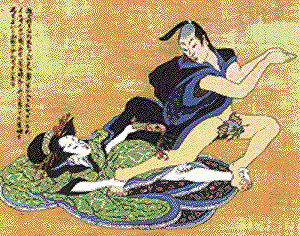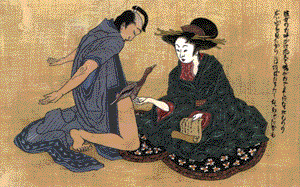K O K I G A M I
The Intimate Art
Of The Little Paper Costume
It is not some sex manual that
promotes a variety of interesting physical positions, but a most ingenious method
of heightening the enjoyment of the sex act by putting the participants in touch
with their inner sexual fantasies. What can be more intriguing!
This Japanese beautifully simple
system allows the mind to get more deeply in touch with the male sexual center
by pretending that it is something else. By slipping a PAPER SCULPTURE of an
animal over his organ, the male is able to give it the qualities of that animal
and relate to it on another level. It instantly becomes far more than a rather
odd piece of blood-engorged flesh with a mind of its own. It is given a new
personality, making the organ much easier to relate to and therefore to understand
and control.
But you musn't get the idea that
KOKIGAMI is all terribly serious and something that only sex therapists should
use. On the contrary, its wonderfully simple techniques are based upon having
a great deal of lighthearted fun, designed to relax and encourage intimacy.
There are no special tricks to
this ART OF THE LITTLE PAPER COSTUME. Some think it has direct links with ORIGAMI,
the art of paper folding, or to KIRIGAMI, meaning cut art. KOKIGAMI probably
evolved from the ancient Japanese art of TSUTSUMI meaning packaging. The word
TSUTSUMI comes from the verb TSUTSUSHIMU, to be descreet. This ethic plays an
important role in gift giving, where it is considered to pass an UNWRAPPED GIFT
to another.
Indeed there is clear evidence
from early literature that men of the upper class WRAPPED THEIR PENISES before
retiring to the conjugal chamber. Several passages in the KOJIKI, a book of
legends dating from AD 712, tell of men spending "much time with fine silks
and ribbons". For the more complex he could make the WRAPPING, the longer
his wife would take to unwrap "THE PRESENT".
"Lovers at Play" from an early 18th century print.

KOKIGAMI: GAMI is the word for
paper, and a KOKI is a small piece of cloth worn at the waist by the supporting
actors (WAKI) in NOH THEATER. All the actors in NOH are male, and they use the
koki in a variety of ways to make quick character changes. It can be used as
a HAT, a BLINDFOLD, a MASK, even a WEAPON. But it was not until late 18th century
when the price of paper fell that it ceased to be the exclusive preserve of
the rich and became popular in Japanese society. KOKIGAMI has attracted a lot
of interest from psychotherapists in America and it seems likely that this ANCIENT
ART will soon enjoy a new popularity in the West.
The Goose was a popular koki in 18th century Japan

